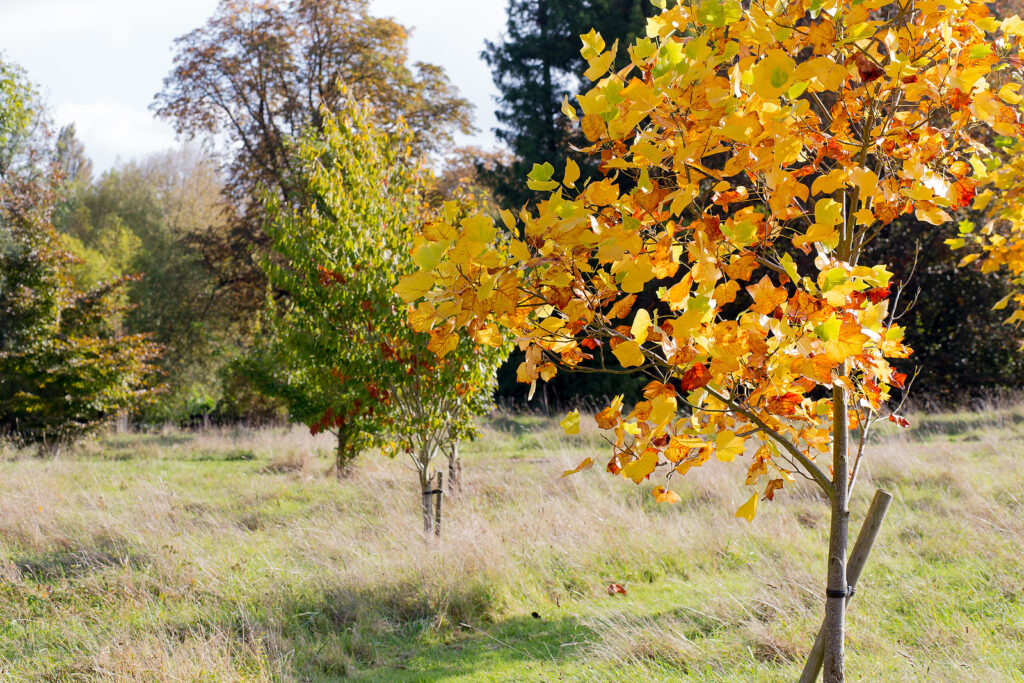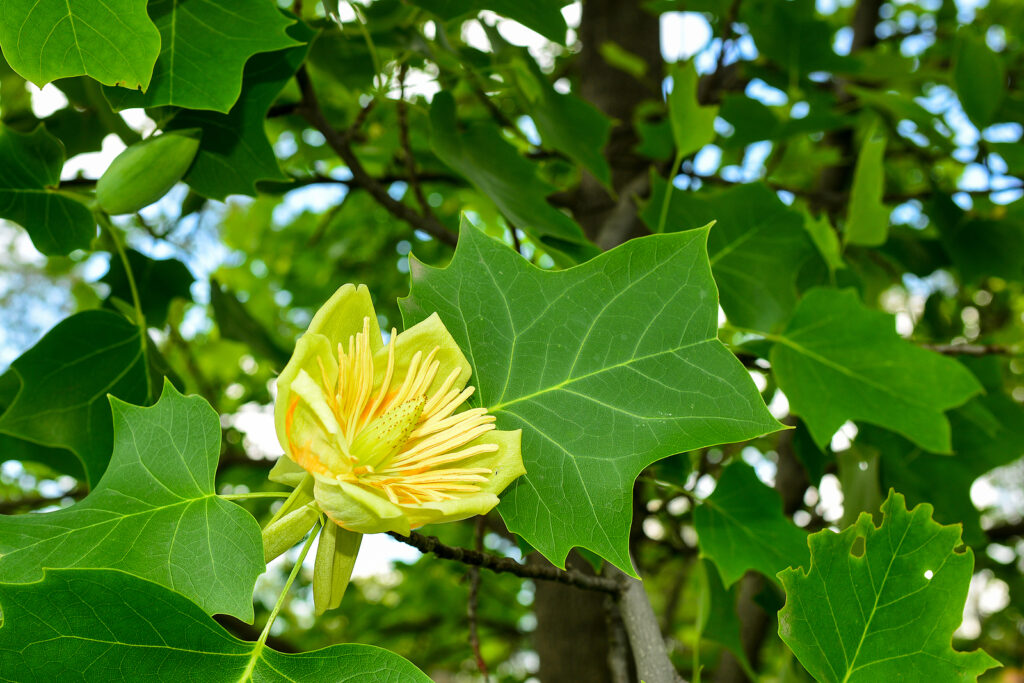Liriodendron — commonly called tulip tree–is a fast-growing, pyramidal-shaped tree that bears tulip-shaped flowers in spring. Liriodendron is deciduous. The leaves are squarish and blunt-tipped looking a bit like a saddle. The leaves turn from bright green to bright yellow in autumn.
Liriodendron’s flowers appear in late spring. They are greenish-yellow and orange at the base. They appear high up in the tree and are sometimes concealed by the leaves. Liriodendrons do not bloom until they are 10 to 12 years old.
Liriodendron can grow to nearly 100 feet (30cm) tall. They need room; they make good shade trees or lawn trees. Liriodendron’s wide-spreading roots grow shallow. Planting under Liriodendron can be a challenge.
Liriodendron is a genus of two species. Liriodendron is native to woodlands in China, Vietnam, and North America.

Get to know Liriodendron
- Plant type: Deciduous tree
- Growing zones and range: Zones 4 to 8
- Hardiness: Hardy to Zone 4
- Height and width: 8-10 foot (2.4-3.1m) tree reaches 25-30 feet (7.6-9.1m) in six to eight years and eventually becomes 70-90 feet (21.3-27.4m) tall with a spread of 35-40 feet (10.7-12.2m)
- Growth rate: Fast
- Form and habit: Pyramidal youth
- Foliage: 2.5-5 inch (6.4-12.7cm) alternate leaves look like a maple leaf squared across the tip and are light green as they unfold in spring, then turn shiny deep green in summer; in autumn they become a clear golden yellow that is sometimes flecked with brown; soft gray bark and a trunk that rises straight up until branching into an oval canopy
- Flowers: Fragrant, solitary 2 inch (5.1cm) tulip-shaped flowers (not until the tree is 10-20 years old); their scent and delicate beauty can scarcely be noticed because by that time the branch tips on which they are borne are high in the air, and the leaves, which open first, hide them from view
- Fruits: 2-3 inch (5.1-7.6cm) conical light brown seed capsules that cling to the branches after the leaves fall
- Bloom time: Late spring to early summer
- Uses: Gardens, shade, specimen, spring flowers, fall color
- Garden companions:
- Common name: Tulip Tree
- Botanical name: Liriodendron
- Family name: Magnoliaceae
- Origin: Eastern regions of North America, China, and Vietnam
Where to plant Liriodendron
- Plant Liriodendron in full sun or partial shade.
- Plant Liriodendron in moist humus-rich but moderately fertile, well-drained soil that is preferably acidic and deep enough to accommodate the tree’s long root structure.
- Liriodendron tolerates seaside conditions if sheltered from wind.

When to plant Liriodendron
- Sow Liriodendron seed in containers in a cold frame in autumn.
- Liriodendron bought balled and burlaped—that is, with their roots in their original soil ball wrapped in burlap—should be planted only in early spring.
Planting and spacing Liriodendron
- Liriodendron need care in transplanting.
- Plant Liriodendron 40-50 feet (12-15m) apart.
How to water and feed Liriodendron
- Give Liriodendron regular water.
- Feed Liriodendron with an all-purpose organic fertilizer in spring.
How to care for Liriodendron
- Prune Liriodendron in winter; old trees rarely require pruning.
Liriodendron pests and diseases
- Avoid damaging the trunk with sharp gardening tools, such as the lawn mower; these wounds are common entry points for pests and diseases.
- Liriodendron are somewhat weak-wooded; too large for most small properties.
- Liriodendron are susceptible to attacks by borers, weevils, leaf miners, scale insects, aphids, and mealy bugs.
- Sooty mold, powdery mildew, antracnose, butt rot, dieback, lesion nematode, and wilt can also occur.

Liriodendron propagation
- Graft Liriodendron in early spring or bud in late summer.
- Take Liriodendron cuttings in summer.
Liriodendron varieties to grow
- Liriodendron chinense, Chinese tulip tree, vigorous, broadly columnar, deciduous tree with saddle-shaped, dark green leaves, to 6 inches (15cm) long; the leaves are squarish, and indistinctly lobed at the tips, hollowed at the bases, with a pointed lobe at each side. A smaller tree not found in many North American nurseries. Has greenish flowers and grows to 80 feet (25m) tall and 40 feet (12m) wide. Zones 6 to 8.
- L. tulipifera, Tulip tree, Tulip poplar, Yellow poplar, grows wild from the southern Canadian border by the Great Lakes, from Massachusetts to Florida and westward to Wisconsin and Mississippi. This magnificent when young but becomes towering and wide spreading when mature, with a massive trunk and several large, outstretched branches high on the trunk. It grows to 100 feet (30m) tall and 50 feet (15m) wide. Leaves measure 3-5 inches (7.6-12.7cm) across and have an unusual blocky shape, with shallow lobes. Borne on long stems, they flutter in the wind. They are bright yellow-green in spring, dark green in summer, and vibrant yellow in late autumn. In late spring, the 2 inch (5.1cm), upright flowers, which are reminiscent of tulips, bloom at the branch tips. Their orange-marked, yellowish green petals attract hummingbirds. Although the flowers are quite pretty, they are not profuse enough to put on a show, and because they bloom high up in the tree, they are easy to overlook. Conelike seedpods develop in fall but are not noteworthy. Trunk bark is gray-brown and furrowed. This is a good-looking shade tree for a large property or a natural landscape. Zones 5 to 9.















